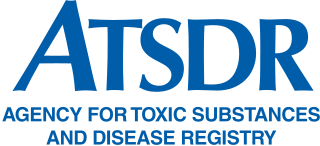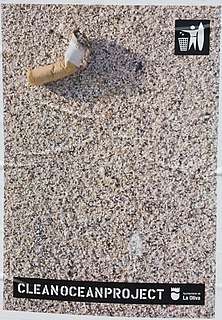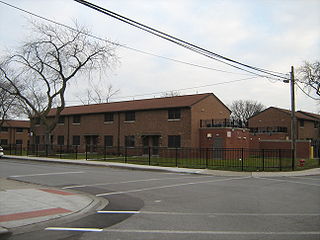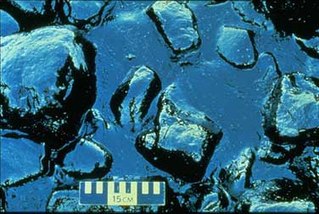
The Environmental Protection Agency (EPA) is an independent executive agency of the United States federal government tasked with environmental protection matters. President Richard Nixon proposed the establishment of EPA on July 9, 1970; it began operation on December 2, 1970, after Nixon signed an executive order. The order establishing the EPA was ratified by committee hearings in the House and Senate. The agency is led by its administrator, who is appointed by the president and approved by the Senate. The current administrator is Michael S. Regan. The EPA is not a Cabinet department, but the administrator is normally given cabinet rank.

In urban planning, brownfield land is any previously developed land that is not currently in use. It may be potentially contaminated, but it is not required to refer for area as brownfield. The term is also used to describe land previously used for industrial or commercial purposes with known or suspected pollution including soil contamination due to hazardous waste.

The Agency for Toxic Substances and Disease Registry (ATSDR) is a federal public health agency within the United States Department of Health and Human Services. The agency focuses on minimizing human health risks associated with exposure to hazardous substances. It works closely with other federal, state, and local agencies; tribal governments; local communities; and healthcare providers. Its mission is to "Serve the public through responsive public health actions to promote healthy and safe environments and prevent harmful exposures." ATSDR was created as an advisory, nonregulatory agency by the Superfund legislation and was formally organized in 1985.

The United States federal Superfund law, officially the Comprehensive Environmental Response, Compensation, and Liability Act of 1980 (CERCLA), established the federal Superfund program, administered by the Environmental Protection Agency (EPA). The program is designed to investigate and clean up sites contaminated with hazardous substances. Sites managed under this program are referred to as "Superfund" sites. There are 40,000 federal Superfund sites across the country, and approximately 1,300 of those sites have been listed on the National Priorities List (NPL). Sites on the NPL are considered the most highly contaminated and undergo longer-term remedial investigation and remedial action (cleanups).

Environmental protection is the practice of protecting the natural environment by individuals, organizations and governments. Its objectives are to conserve natural resources and the existing natural environment and, where possible, to repair damage and reverse trends.

The National Environmental Policy Act (NEPA) is a United States environmental law that promotes the enhancement of the environment and established the President's Council on Environmental Quality (CEQ). The law was enacted on January 1, 1970. To date, more than 100 nations around the world have enacted national environmental policies modeled after NEPA.
The Commission for Environmental Cooperation was established by Canada, Mexico, and the United States to implement the North American Agreement on Environmental Cooperation (NAAEC), the environmental side accord to the North American Free Trade Agreement. The CEC's mission is to facilitate cooperation and public participation to foster conservation, protection and enhancement of the North American environment for the benefit of present and future generations, in the context of increasing economic, trade and social links among Canada, Mexico and the United States.
The Inter-Tribal Environmental Council (ITEC) was set up in 1992 to protect the health of Native Americans, their natural resources and environment. To accomplish this ITEC provides technical support, training and environmental services in a variety of disciplines. Currently, there are over forty ITEC member tribes in Oklahoma, New Mexico, and Texas. The ITEC is an example of the Native American Pan-Indian Organizations and Efforts.

Lisa Perez Jackson is an American chemical engineer who served as the administrator of the United States Environmental Protection Agency (EPA) from 2009 to 2013. She was the first African American to hold that position.

Altgeld Gardens Homes is a Chicago Housing Authority (CHA) public housing project located on the far south side of Chicago, Illinois, United States. It sits on the border of Chicago and Riverdale, Illinois. The residents are 97% African-American according to the 2000 United States Census. Built between 1944 and 1945 with 1,498 units, the development consists primarily of two-story row houses spread over 190 acres (0.77 km2).
"Right to know" empowers "people by allowing them to participate in an informed way in decisions that affect them, while also holding governments and others accountable". It pursues universal access to information as essential foundations of inclusive knowledge societies.

As with many countries, pollution in the United States is a concern for environmental organizations, government agencies and individuals.

Robert Doyle Bullard is an American academic who is the former Dean of the Barbara Jordan - Mickey Leland School Of Public Affairs and currently Distinguished Professor at Texas Southern University. Previously Ware Professor of Sociology and Director of the Environmental Justice Resource Center at Clark Atlanta University, Bullard is known as the "father of environmental justice". He has been a leading campaigner against environmental racism, as well as the foremost scholar of the problem, and of the Environmental Justice Movement which sprung up in the United States in the 1980s.

Land recycling is the reuse of abandoned, vacant, or underused properties for redevelopment or repurposing.

The Arctic policy of the United States is the foreign policy of the United States in regard to the Arctic region. In addition, the United States' domestic policy toward Alaska is part of its Arctic policy.
The Worker Protection Standard is intended to protect employees on farms, forests, nurseries, and greenhouses that are occupationally exposed to agricultural pesticides.

The Clean Water Rule is a 2015 regulation published by the U.S. Environmental Protection Agency (EPA) and the United States Army Corps of Engineers (USACE) to clarify water resource management in the United States under a provision of the Clean Water Act of 1972. The regulation defined the scope of federal water protection in a more consistent manner, particularly over streams and wetlands which have a significant hydrological and ecological connection to traditional navigable waters, interstate waters, and territorial seas. It is also referred to as the Waters of the United States (WOTUS) rule, which defines all bodies of water that fall under U.S. federal jurisdiction. The rule was published in response to concerns about lack of clarity over the act's scope from legislators at multiple levels, industry members, researchers and other science professionals, activists, and citizens.
Southwest Workers Union (SWU), previously Southwest Public Workers Union (SPWU), is a grassroots nonprofit community organizing group in the United States with over 3,000 members who have been working for 30 years to combat environmental racism and worker injustice. Their goal is to organize “low-income workers and families, community residents, and youth, united in one organizational struggle for worker rights, environmental justice and community empowerment.” SWU does this through educating and strengthening community leaders and emphasizing direct action on issues that impact these communities.
Environmental racism is the concept that minority and low-income communities experience environmental harms, such as pollution and natural disasters, at a disproportionately high rate. Environmental racism is a form of institutionalized discrimination, which is defined as "actions or practices carried out by members of dominant groups that have differential and negative impacts on members of subordinate groups."











